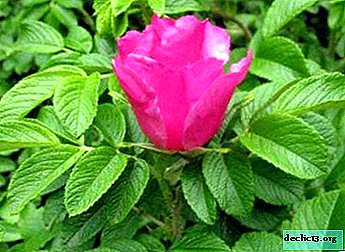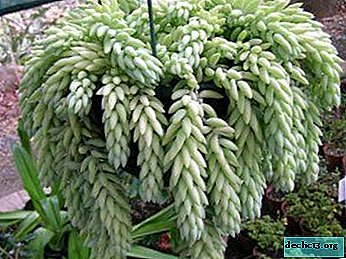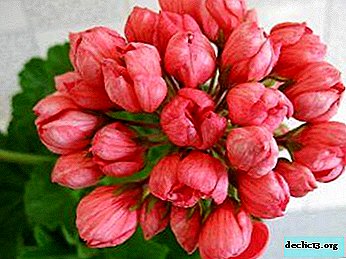Dangerous diseases and pests of the Decembrist. Treatment and control

Schlumbergera or Decembrist is the name of the same plant, which is successfully grown at home. The culture belongs to the genus of epiphytic cacti. In nature, the Decembrist prefers to grow in the tropical forests of southeast Brazil. The height of the plant reaches 2.8 m. For the first time, zigocactus was introduced to Europe in the 19th century, so that since then it has become one of the most popular domestic plants. And although it is completely easy to care for him, there are situations when you have to deal with pests and diseases. The article describes why zygocactus is sick and does not grow and other main problems that may arise, as well as how to reanimate a flower at home.
Diseases and their photos and treatment
Fungal infections of Schlumbergera
Phytophthora and Podium
These two diseases are transmitted with contaminated soil and cause damage to the original root cervix. The very first symptom of the disease is the massive fall of the segments, flower wilting with increased soil moisture (about why the Decembrist has sluggish soft leaves and how to fix the situation, read here). After that, the plant acquires a gray or pale color. For treatment, use the following drugs:
- Coming soon To 1 liter of water 1 ml of the drug. The flow rate of the solution is 0.5 l per plant.
- Topaz. To spray the plants, take 2 ml of the drug per 10 liters of water. Treat at the first sign of illness.
- Maksim. Dilute 5 drops of the drug in 200 ml of water. Use spray agent.
- Vitaros. Dilute 2 ml of the drug in 2 l of water. Spray 2 times with an interval of 10 days.

Fusarium
This is a fungal disease of zigocactus, the development of which is influenced by a fungus of the genus Fusarium. It penetrates the plant through the soil and wounds, leading to decay of the root system and neck. For prevention, drugs such as Mikol and Bayleton are used. If infection with fusarium has occurred, then it is already impossible to cure it.
When the lesion becomes apparent and the vascular system is damaged, then remove the diseased specimen and burn it, and treat the soil in which it grew with a weak solution of potassium permanganate.

Bacterial lesion
The most common bacterial lesion remains what occurs against the background of Erwinia bacterial groups. The symptomatology is as follows: first, at the base of the stem, a wet, sliding dark spot forms, and if you do not take any action, it will begin to cover the entire stem.
Some related bacterial diseases lead to discoloration of the stem tissue, resulting in a reddish tint. To the touch this place becomes slippery. It is useless to use antibacterial drugs, and the affected part of the flower should be removed.If only part of the stem is affected, it is easier to break off the stalk above the stem and notice a diseased plant, growing new from the petiole.

Flower pests and control
Spider mite
This parasite can cause significant damage to the plant. If you look closely, you can see the spider mite with the naked eye. Small insects, may have yellow, brown and red color. The main reason for the development of the spider mite is dry air. If this pest lives on the Decembrist, then It is worth treating the plant with the following drugs:
- Fitoverm.
- Neoron.
- Actellic.
Between treatments it is necessary to observe intervals that depend on the temperature of the air in the room:
- +20 degrees - 9-10 days;
- +30 degrees - 3-4 days.
Save the Decembrist:
- At the first symptoms of damage, you need to thoroughly wash the flower with laundry soap, then re-soap and leave it in the same form for 2 hours.
- After the solution has been removed with water, put a plastic bag on the plant and leave it for 7-10 days.
- Such manipulations should be carried out after another 7 days, since the laid eggs of the spider mite may remain after the first procedure.
After processing, it is necessary to increase the air humidity by spraying or placing the flower in a pan with wet pebbles.

Mealybug
This is a sucking insect, which has an oval pink body, covered with a white coating. On his back there are transverse stripes. The length of the parasite is 3-7 mm. You can detect a mealybug by the presence of white sticky mucus on the leaves of the flower. The buds of a plant suffer from an insect, fade and fall.
For prevention, it is necessary to regularly water and remove dried leaves. If infection has occurred, then the bush will have to be treated with the insecticide Aktar or Confidor. 200 ml of water accounts for 2 ml of the drug. Spray the resulting solution with the plant, and repeat the procedure after 7 days.
From folk remedies, the following recipes remain effective:
- Mash 25 g of garlic, add 1 liter of boiling water. Insist for 6 hours, and then wipe the plant with a brush dipped in infusion. Such events should be carried out in the evening. Cover the flower for 2 days from the sun.
- Mix 1 liter of water and 40 ml of olive oil. Moisten a cotton pad in the solution and walk through all the elements of the plant.
- Grind 10-15 g of green soap, add to 1 liter of water. Spraying should be done 3 times, observing intervals of 7 days.

Shield
The dimensions of this parasite do not exceed 5 mm. Scale shield sucks from the Decembrist all the juices. After that, the leaves turn yellow and dry. If you do not start treatment in a timely manner, then the flower may die.
To combat the parasite, you must use mechanical cleaning. Its essence is to apply a solution of Karbofos or Tanker on a cotton pad. Walk with a fleece over the affected areas of the plants. You can use Ankara solution for processing (8 g of the drug per 10 liters of water). In addition, it is necessary to review the humidity in the room so that it is not lower than 60%. Bright sunlight also slows their development.
From folk remedies, you can try the following:
- Combine 1 liter of water and 40 g of laundry soap. Add 5 drops of kerosene to the solution and shake thoroughly. Wipe the composition of the problem areas of the Decembrist.
- Take a medium-sized onion, chop finely and pour 200 ml of water. Insist for 2-3 hours, filter and moisten a cotton pad in the solution, go to problem areas.

We offer you to watch a video about pests of Decembrist and how to deal with them:
Why is it turning yellow?
Quite often, the segments of the Decembrists turn yellow. This occurs as a result of low humidity. To prevent this, it is necessary to organize the flower thorough watering and increase air humidity. Regularly spray the plant with warm water using a spray gun. Another reason for the yellowing of the Decembrist is the scab.
What to do if frozen?
How to revive a flower? If the Decembrist froze, dropped the buds, then you have to carefully examine the leaves of the plant. If they have not faded, then you can save the flower. In no case do you need to drastically change the growing conditions. Set the pot with a bush in a cool place where the air temperature is 18 degrees.
Only there should be no draft. It is also necessary to take care of high-quality lighting without direct sunlight. You can perform the treatment of the plant with Epina, but do not water it. If resuscitation was successful, then the flower should come to life and begin to form buds.How to reanimate and save a badly damaged and dying plant?
The Decembrist can die for various reasons: too low temperature, excessive watering, lack of light, insufficient nutrition. You can save the affected plant by re-rooting. The essence of this procedure is as follows:
- Nip off 3-4 leaves, set them in water and after 12-14 days, roots should appear.
- Buy soil for cacti (Garden of Miracles), pour it into a container with drainage holes.
- Transplant the flower into a pot, pour warm water.
- Transplant the old flower into fresh soil and water less. After transplanting, do not feed for a month.
Decembrist is a very beautiful plant that is successfully grown at home. Of course, like any room flower, it can hurt. The main task of the grower is to comply with all conditions for the cultivation of Schlumbergera, to prevent waterlogging, oversaturation with nutrients and to cure all diseases in a timely manner.

















